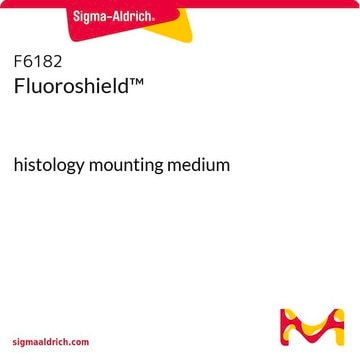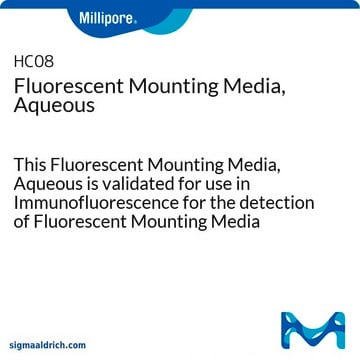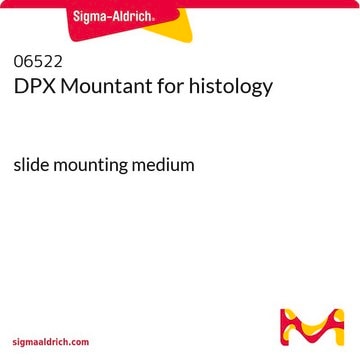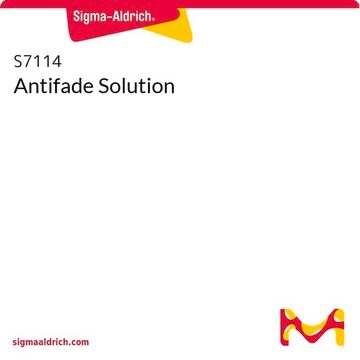Recommended Products
product name
Fluoromount™ Aqueous Mounting Medium, for use with fluorescent dye-stained tissues
Quality Level
form
liquid
color
clear
suitability
suitable for immunohistochemistry
application(s)
diagnostic assay manufacturing
hematology
histology
General description
Fluoromount is an aqueous based mounting medium,similar to Gel Mountä, for use with coverslips to preserve tissues stained with fluorescent dyes. Thisproduct is compatible with FITC, phycoerythrin, phycocyanin, and allophycocyanin labeling. It can alsobe used with other fluorescent markers such as TexasRedÒand rhodamine. The medium after use can easily be removed by soaking the slides in deionized water.
Application
Fluoromount™ Aqueous Mounting Medium has been used for mounting:
- coverslips on slides for immunofluorescence microscopic examination of PC12 and Hela cells
- hippocampus neurons cells for confocal microscope studies
- brain sections for immunofluorescence staining
Legal Information
Fluoromount is a trademark of Diagnostic BioSystems, Inc.
related product
Product No.
Description
Pricing
Storage Class Code
10 - Combustible liquids
WGK
WGK 3
Flash Point(F)
Not applicable
Flash Point(C)
Not applicable
Certificates of Analysis (COA)
Search for Certificates of Analysis (COA) by entering the products Lot/Batch Number. Lot and Batch Numbers can be found on a product’s label following the words ‘Lot’ or ‘Batch’.
Already Own This Product?
Find documentation for the products that you have recently purchased in the Document Library.
Customers Also Viewed
Biophysics of microchannel-enabled neuron-electrode interfaces
Wang L, et al.
Journal of Neural Engineering, 9(2), 026010-026010 (2012)
David Fast et al.
mBio, 9(4) (2018-08-02)
Adult Drosophila melanogaster raised in the absence of symbiotic bacteria have fewer intestinal stem cell divisions and a longer life span than their conventionally reared counterparts. However, we do not know if increased stem cell divisions are essential for symbiont-dependent
Kyle J Martin et al.
Proceedings of the National Academy of Sciences of the United States of America, 113(51), 14769-14774 (2016-12-09)
Teeth and denticles belong to a specialized class of mineralizing epithelial appendages called odontodes. Although homology of oral teeth in jawed vertebrates is well supported, the evolutionary origin of teeth and their relationship with other odontode types is less clear.
Sukant Garg et al.
Marine drugs, 17(6) (2019-06-15)
Fucoxanthin is commonly found in marine organisms; however, to date, it has been one of the scarcely explored natural compounds. We investigated its activities in human cancer cell culture-based viability, migration, and molecular assays, and found that it possesses strong
Mohammed Oufattole et al.
Endocrinology, 147(5), 2138-2146 (2006-02-04)
IGF-binding protein (IGFBP)-3 has intrinsic antiproliferative and proapoptotic functions that are independent of IGF binding and may involve nuclear localization. We determined that exogenous IGFBP-3 rapidly translocates to myoblast nuclei and that a 22-residue peptide containing the metal binding domain
Our team of scientists has experience in all areas of research including Life Science, Material Science, Chemical Synthesis, Chromatography, Analytical and many others.
Contact Technical Service











